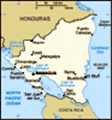Advertisement
We took the rest of the morning to clean-up which was difficult to do since we hadn't yet gone shopping and had to split a tiny bottle of hotel shampoo and a mini bar of soap between the two of us. There also wasn't a heck of a lot of water pressure. But, I still felt 100%!b(MISSING)etter afterward. Before heading out to see the rest of León we stopped by the Ticabus office to purchase our onward tickets from Granada to Liberia, Costa Rica. We were lucky and scored 2 of the last 5 seats on any busses that left April 15-16. I wasn't able to book this ahead of time and being Easter the busses had booked up quickly.
We had a lovely lunch at a local commodore (eatery) before visiting more of this lovely city. Today was museum day; today I learned more about Nicaraguan history than I ever knew...
Museum of Legends & Traditions (Museo de Leyendas y Tradiciones) This museum is quite bizarre and has 2 significantly different themes. It was originally used as a prison during the Somoza dictatorship and many of the displays are with this in mind. The
rest of the museum relates to the folk traditions (and superstitions) of Nicaragua. The museum is on the grounds of a prison built in 1921 that came to be known as Prison XX1. It was the site of many human rights abuses and torture of prisoners. It remained a prison until 1979 the Sandinista forces breached the defenses of the National Guard and released the prisoners. It would later re-open in 1993 as a museum that showcased both the history of the prison, but also presented displays of folklore traditions. The founder Doña Carmen Toruño began the museum in her home and later moved it to this site. Our english-speaking guide explained a great deal of the history but the most moving thing I heard was the translation of words of another guide who had once been a prisoner in this very building. He gave his entire explanation in the courtyard because he had too many horrible memories to go inside. On display are papier-mâché figurines and puppets that tell important folk tale traditions while along the walls are grey-scale paintings that show the prison cells and torture rooms from it’s history as a prison.
Church of San Sebastián (ruins)
Built in the late 17th century as a chapel of the Cathedral, San Sebastián's was one of the first religious buildings in the city. Re-built in the late 18th century by Colonel Joaquín Arrechavala, it was bombed during the siege of León by airplanes of the regime's Nicaraguan Air Force in 1979. Since it was built with adobe bricks San Sebastián's was easily destroyed, unlike other churches built in brick or stone which endured shootings and bombings. The ruins of this church are directly across the street from the Museum of Legends & Traditions, perhaps that had something to do with its being bombed at the start of the 1979 revolution.
Revolution Museum (Museo de la Revolución) The Revolution Museum is located in an enormous building just off the central plaza. The museum is less about the objects on display, and more about the building itself and those inside. Housed in a former Somoza government building, it was a central location during the Sandinista revolution in the city. The ground floor has small displays that introduce the history of the period, as well as photographs of those who fought in the
war. Falling apart since 1979, former Sandinista revolutionary fighters worked to turn this building into a museum. They clearly did not have a large budget. Our tour was given with a great deal of passion for the cause. I did not realize how much influence the Americans have had in this region dating back to the early 1900s.
The staircases are covered in dust, paint is peeling off the walls. As you walk the quiet area of this building you notice that many of the walls are filled with tiny marks, which are likely bullet holes from the intense fighting that took place here. It's easy to imagine the noise and pain that would have filled this building only a generation ago.
Many of the guides of the museum are past Sandinista revolutionaries (as was ours). In fact, we wouldn't have likely visited this museum at all except that I knew the man that I'd previously overheard was also a guide here (I'd met him a few days earlier). We should have ended our tour on the roof, but in fact we began our tour there as another Canadian couple were just finishing theirs. The view was stellar
and by far the best vantage point by which to photograph the Cathedral across the square.
Advertisement
Tot: 0.122s; Tpl: 0.015s; cc: 9; qc: 55; dbt: 0.0682s; 1; m:domysql w:travelblog (10.17.0.13); sld: 1;
; mem: 1.2mb









